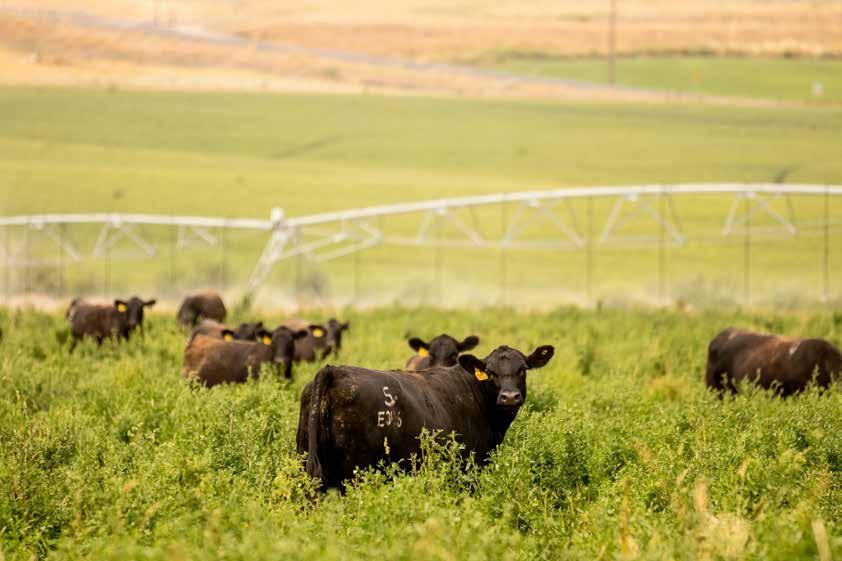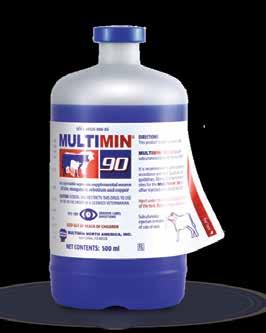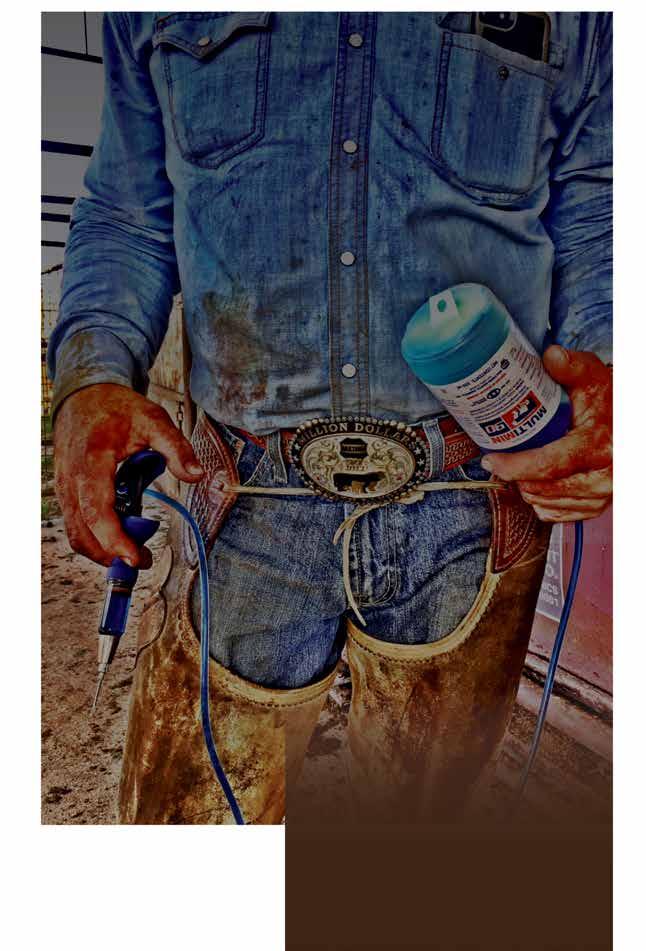
7 minute read
Angus pounds and premiums
BEST OF BOTH WORLDS Opportunity for a bottom line filled with pounds and premiums
by Abbie Burnett for Certified Angus Beef
Would you rather have AC or heat? Only meat or vegetables for dinner? Do you want the profit from your cattle to come from pounds or quality?
These are decisions you don’t have to make.
Brian Bertelsen, U.S. Premium Beef (USPB) vice president of field operations, addressed cattle questions with data at the Beef Improvement Federation’s recent online symposium.
He began by defining premium as the difference between the amount paid on USPB’s value-based grid and the previous week’s USDA-reported average cash market.
“Last year, we had a record-high quality grade premium,” he said, noting some groups earned record high total premiums above cash late in 2019 when the rewards for quality were especially high in the marketplace. “Prior to that, premiums were hanging around $50 per head.”
Marbling and dressing percent were the two key profitability traits, the latter of importance because the grid pays on hot carcass weight (HCW) rather than live weight.
Bertelsen showed the 22-year span of company grade and premium data, commenting on the mostly steady increase in HCW and average premiums paid. Drought caused zigzags in 2006 and again six years later. The introduction of such technology as ultrasound and genomic testing stimulated quality grade improvement early in this century and 10 years later, respectively.
More pounds have been a familiar feature.
“We’ve been increasing carcass weight and live weight ever since we learned how to build fence and selectively breed cattle,” Bertelsen said. “That’s obviously one of the first things we’re focused on because that’s our pay weight.”
Increasing HCW is nothing to be ashamed of.
“This is our competitive advantage,” he said. “We’re really not increasing cow numbers. We’re allowing our industry to feed more people with a lot of pounds of total product from less animals.”
Adding weight can be a key to profit.
“My job is to coach our producers and give them some suggestions, things to do and try,” Bertelsen said. “One of the things I’m talking to them about lately is, ‘Hey, the better your cattle are for genetics, for carcass traits, and let’s say for specifically marbling, really the longer you ought to feed those cattle… if I don’t feed him very long, I don’t allow him or her to maximize their genetic potential.’”
Studying data and trends over the years, Bertelsen watched dynamic shifts develop.
“Remember the drought year in 2006 led to lower grades and there was a high Choice-Select spread. That’s logical, right? But also remember how high the grades have been the last couple of years and the Choice-Select spread has also been pretty high. Well, that doesn’t make a whole lot of sense,” he said.
Until you look at the steeply declining share of fed cattle grading Select across those 22 years.
“The whole industry went from 37 percent down to 14 percent Select. Such a huge decrease in availability pushed some large meat customers out of Select and into Choice
...CONTINUED ON PAGE 34

RANCHO CASINO DAL PORTO LIVESTOCK & 29 th Annual Bull Sale Thursday, September 17 • 1 p.m. • Rancho Casino, Denair CA




Selling 150 Angus Bulls & 20 Herefords
NEW THIS YEAR... FOR THE FIRST TIME IN 25 YEARS, WE ARE SELLING 40 LOTS OF OUR BEST FEMALES. INCLUDING 16 DAUGHTERS OF CASINO BOMBER N33 & EMBRYOS BY OUR BEST DONORS!
Casino BomberS161 DPLBomberX15 DPLAshland X13
Reg No. 19696653 • DOB: 08/11/2019 Casino Bomber N33 X Connealy Black Granite
BW
+0.7 WW
+100 YW
+156 DOC
+25 CW
+70 MARB
+.31 RE
+.81 $M
+71 $W
+94 $B $C
+139 +251

Casino JiltS162
CED
+10
Reg No. 19775879 • DOB: 02/18/2019 Casino Bomber N33 X Sitz Upward 307R
BW
+0.3 WW
+83 YW
+141 DOC
+15 CW
+69 MARB
+.48 RE
+.72 $M
+53 $W
.89 $B $C
+147 +244

Casino Isabel R150
Reg No. 19658557 • DOB: 02/07/2019 G A R Ashland X Connealy Right Answer 746
CED
+12 BW
+1.5 WW
+79 YW
+134 DOC
+27 CW
+62 MARB
+.71 RE
+.92 $M
+68 $W
+86

DPLFoxyErica 7260
Reg No. 19744856 • DOB: 08/12/2019 Casino Bomber N33 X Musgrave Big Sky
BW
+2.7 WW
+101 YW
+167 DOC
+22 CW
+88 MARB
+.76 RE
+.49 $M
+76 $W $B $C
+107 +183 +313
Reg No. 19544169 • DOB: 08/16/2018
Connealy Confidence Plus x EF Commando 1366
CED
+5 BW
+0.9 WW
+88 YW
+156 DOC
+24 CW
+73 MARB RE $M
+.72 +1.10 +77 $W $B $C
+104 +169 +296 CED
+7
Reg No. 19767126• DOB: 08/12/2017 Basin Advance 3134 X A A R Ten X 7008 S A
BW
+1.7 WW
+78 YW
+139 DOC
+13 CW
+72 MARB
+1.07 RE
+.55 $M
+83 $W
+119
Plus 20 Hereford bulls from Hoffman Herefords, Thedford, Nebraska

Online viewing and bidding available sale day at

David & Jeanene Dal Porto 5031 Jersey Island Rd • Oakley, CA 94561 (925) 634-0933 • mobile: 925-250-5304 www.dalportolivestock.com

David & Carol Medeiros 2800 Hall Rd • Denair, CA 95316 • (209) 632-6015 David mobile: 209 765 0508 • Matt Angell (559) 217-9064 www.ranchocasinoangus.com
whether they wanted to or not,” Bertelsen said. Today’s wider spread is all about the discount for an increasingly irrelevant grade.
Looking again at drought years like 2006 and 2012, he noted increases in yield grade discounts.
“If we’re in a period of time when we have a higher percentage of yield grade (YG) 4s and 5s, it’s really more attributable to changes in muscling,” he said, “which I attribute to environment.”
Data indicate YG3 is a gateway to premium Choice. Summaries show quality grade, HCW and YG all moving higher together.
“It’s rather challenging, even with good genetics to produce a lot of Prime cattle with a really low yield grade,” Bertelsen noted. “They’re both fat – marbling and back fat – so we need to allow these cattle some time again to express their genetic potential.”
The relationship between yield grades and HCW are part of the increase in dollars per head on the USPB grid versus the cash market. As yield grade increases, so does HCW.
“Each year, yield grade 3s are the maximum price per hundredweight, but 4s are usually the most total dollars per head,” Bertelsen said.
He compared the top eight ranches (4,000 head) to the USPB grid average. Those eight averaged just 13 lb. lighter HCW, but graded 99 percent Choice and Prime compared to 87 percent company average. They also qualified more than 80 percent for the Certified Angus Beef ® (CAB ® ) brand, with 51 percent Prime or CAB Prime. The company average was 6 perecentPrime.
Those numbers show what people can do with modern genetics, focused management and grid marketing incentives, Bertelsen said.
While noting all the company data deals with cattle phenotypes, he closed with an example from one USPB member that compared progeny from two bulls with above-average Angus $B, but one significantly higher than the other. If used on both spring and fall herds to generate 50 progeny per year for five years, the better bull could add more than $39,000 on the grid.
No balancing needed. Benefits await for pounds and premiums.















